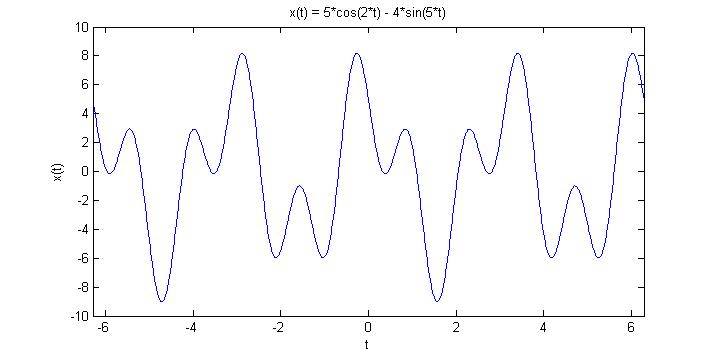(→Periodic CT Signal and Its Fourier Coefficients) |
(→Periodic CT Signal and Its Fourier Coefficients) |
||
| Line 1: | Line 1: | ||
== Periodic CT Signal and Its Fourier Coefficients == | == Periodic CT Signal and Its Fourier Coefficients == | ||
| + | |||
| + | A Fourier Series of a periodic CT signal is such that:<br> | ||
| + | <math> x(t) = \sum_{n=-\infty}^\infty a_k * e</math><sup>(<math>j*k*w_0*t</math>)</sup> | ||
| + | |||
Take the signal <math> x(t) = 5cos(2t) - 4sin(5t) </math>. The graph below proves that it is indeed periodic, with a period <math> T = \pi </math>. | Take the signal <math> x(t) = 5cos(2t) - 4sin(5t) </math>. The graph below proves that it is indeed periodic, with a period <math> T = \pi </math>. | ||
| Line 15: | Line 19: | ||
<math> x(t) = 5 * \frac{1}{2} * (e</math><sup>(j2t)</sup> <math> \,\ + e</math><sup>(-j2t)</sup><math> \,\ ) - 4 * \frac{1}{5j} * (e</math><sup>(j5t)</sup> <math> \,\ - e</math><sup>(-j5t)</sup><math> \,\ )</math> | <math> x(t) = 5 * \frac{1}{2} * (e</math><sup>(j2t)</sup> <math> \,\ + e</math><sup>(-j2t)</sup><math> \,\ ) - 4 * \frac{1}{5j} * (e</math><sup>(j5t)</sup> <math> \,\ - e</math><sup>(-j5t)</sup><math> \,\ )</math> | ||
| + | |||
<math> \,\ x(t) = \frac{5}{2} * e</math><sup>(j2t)</sup> <math> \,\ + \frac{5}{2} * e</math><sup>(-j2t)</sup><math> - \frac{4}{5} * e</math><sup>(j5t)</sup> <math>+ \frac{4}{5} * e</math><sup>(-j5t)</sup> | <math> \,\ x(t) = \frac{5}{2} * e</math><sup>(j2t)</sup> <math> \,\ + \frac{5}{2} * e</math><sup>(-j2t)</sup><math> - \frac{4}{5} * e</math><sup>(j5t)</sup> <math>+ \frac{4}{5} * e</math><sup>(-j5t)</sup> | ||
| + | |||
| + | |||
The period <math> \,\ T = 2\pi </math> so if <math> \,\ w_0 = \frac{2\pi}{T} </math>, then <math> \,\ w_0 = 1 </math>. | The period <math> \,\ T = 2\pi </math> so if <math> \,\ w_0 = \frac{2\pi}{T} </math>, then <math> \,\ w_0 = 1 </math>. | ||
Revision as of 14:57, 25 September 2008
Periodic CT Signal and Its Fourier Coefficients
A Fourier Series of a periodic CT signal is such that:
$ x(t) = \sum_{n=-\infty}^\infty a_k * e $($ j*k*w_0*t $)
Take the signal $ x(t) = 5cos(2t) - 4sin(5t) $. The graph below proves that it is indeed periodic, with a period $ T = \pi $.
$ \,\ sin(x) = \frac{1}{2j} * (e $(jx) $ \,\ - e $(-jx)$ \,\ ) $
and
$ \,\ cos(x) = \frac{1}{2} * (e $(jx) $ \,\ + e $(-jx)$ \,\ ) $
Therefore,
$ x(t) = 5 * \frac{1}{2} * (e $(j2t) $ \,\ + e $(-j2t)$ \,\ ) - 4 * \frac{1}{5j} * (e $(j5t) $ \,\ - e $(-j5t)$ \,\ ) $
$ \,\ x(t) = \frac{5}{2} * e $(j2t) $ \,\ + \frac{5}{2} * e $(-j2t)$ - \frac{4}{5} * e $(j5t) $ + \frac{4}{5} * e $(-j5t)
The period $ \,\ T = 2\pi $ so if $ \,\ w_0 = \frac{2\pi}{T} $, then $ \,\ w_0 = 1 $.


